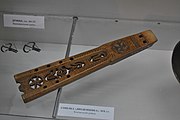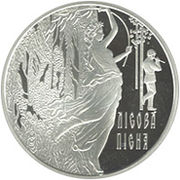Sopilka
 Sopilka Prima | |
| Woodwind instrument | |
|---|---|
| Classification | Woodwind |
| Hornbostel–Sachs classification | 421.111-12 |
| Playing range | |
| C3–G5 | |
| Related instruments | |
Sopilka (, Ukrainian: Cопiлка) is a name applied to a variety of woodwind instruments of the flute family used by Ukrainian folk instrumentalists.[1] Sopilka most commonly refers to a fife made of a variety of materials (but traditionally out of elderberry or viburnum wood) and has six to ten finger holes.[2] The term is also used to describe a related set of folk instruments similar to recorder, incorporating a fipple and having a constricted end.
Sopilkas are used by a variety of Ukrainian folkloric ensembles recreating the traditional music of the various sub-ethnicities in western Ukraine, most notably that of the Hutsuls of the Carpathian Mountains. Often employing several sopilkas in concert, a skilled performer can mimic a variety of sounds found in nature, including bird-calls and insects.
History
[edit]Sopilka is one of the oldest music instruments: the earliest known sopilka ever found is made of mammoth-bone and is from the Paleolithic age.[1] It is also depicted in many 11th century's stories and paintings, such as a fresco in Saint Sophia Cathedral, Kyiv.[1] At first, it used to be solely a folk instrument, played by shepherds or by trios (named ktroisti myzyky)[1] and sometimes played during weddings.[2] It is also cited in the play The Forest Song by Lesya Ukrainka.[2]
Modern usage
[edit]With the development of the 10 hole fingering instruments in 1967,[1] sopilkas became part of the music education system in Ukraine. Pop groups began to use the instrument in their performances. The first was the folk rock group Kobza. More recently, the sopilka has found its way into the music of singer Ruslana, folk rock band Haydamaky, speed folk group Kubasonics,[3] folktronica bands Onuka and Kazka,[2] and flautist Ihor Didenchuk from the folktronica groups Go_A and Kalush.[4]
Varieties
[edit]There are many types of flute-like instruments in Ukraine. Some varieties include dentsivka (including dvodentsivka and pivtoradentsivka), dudka-vykrutka, floyara, floyarka, frilka, telenka, and zubivka.
Gallery
[edit]See also
[edit]References
[edit]- ^ a b c d e "Sopilka". Encyclopedia of Ukraine. Vol. 4. 1993. Retrieved 2024-03-30.
- ^ a b c d "Sopilka | Center for Russian, East European, & Eurasian Studies". University of Kansas. Retrieved 2024-03-30.
- ^ Lander, Nicholas S. (1996–2024). "Recorder Home Page: Sopilka". Recorder Home Page. Retrieved 2024-03-30.
- ^ "2020 participants: Go_A". Eurovision.tv. Retrieved 2024-03-26.
Sources
[edit]- Dverij, R. – Shkola hry na khromatychnii sopiltsi - Lviv, 2008. - Part 1 - 72 pages, part 2 - 68 pages, part 3 - 64 pages.
- Humeniuk, A. – Ukrainski narodni muzychni instrumenty - Kyiv: Naukova dumka, 1967
- Mizynec, V. – Ukrainian Folk Instruments - Melbourne: Bayda books, 1984
- Cherkaskyi, L. – Ukrainski narodni muzychni instrumenty - Tekhnika, Kyiv, Ukraine, 2003 - 262 pages. ISBN 966-575-111-5



